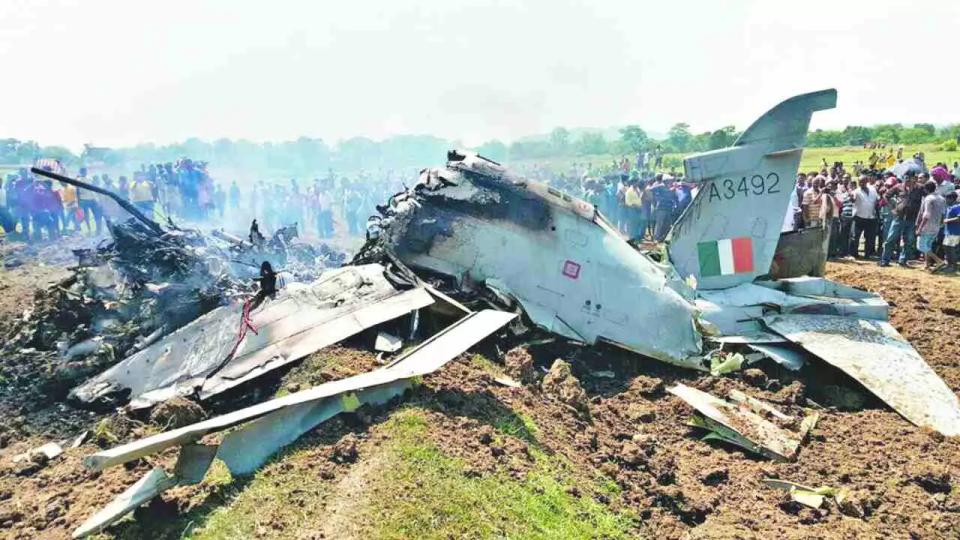India’s Air Force Loses 534 Aircraft in 30 Years — 152 Pilots Dead in Shocking Safety Crisis
A legacy of accidents, political delays and operational overstretch leaves India’s air power on a knife’s edge as rivals modernise.

Over the past 30 years, India’s Air Force has recorded the loss of a shocking 534 aircraft spanning fighters, trainers, helicopters and transport planes — an appalling safety record by any global military standard.
These staggering figures, meticulously compiled by defence analyst Anchit Gupta from India’s parliamentary Q&A archives, lay bare the operational dangers the IAF has long wrestled with as ageing airframes meet modern mission demands.
In stark human terms, at least 152 IAF pilots have lost their lives during this period — a sobering reminder of the true cost of flying “vintage” jets into the 21st century.
Much of the blame lies with the MiG-21, India’s longest-serving supersonic fighter, which has carried the grim nickname “flying coffin” for decades.
According to Gupta’s findings, the worst years fell during the 1990s, when the IAF routinely lost 20 to 30 aircraft annually — the lion’s share involving the notoriously unforgiving MiG-21 Bison.
Nicknamed the “flying coffin” by generations of pilots, the MiG-21’s safety record is among the worst for any combat aircraft still in service today.
Designed by the Soviet Union as a second-generation interceptor in 1959, the MiG-21 entered IAF service in the early 1960s, giving India much-needed supersonic air cover during the Cold War era.

Yet its legacy design, primitive avionics and limited safety systems have turned the type into an aerial relic.
India did attempt to extend the MiG-21’s relevance by upgrading some airframes to the Bison variant, adding Israeli radars, new missiles and improved electronic warfare capabilities.
But these modern touches could never change the aircraft’s fundamental DNA — an ageing fuselage that has now surpassed 60 years in service.
Spares shortages, structural fatigue and a poor safety envelope only compound the danger for young pilots, many of whom still train on MiG-21s before transitioning to frontline platforms like the Su-30MKI and Rafale.
The MiG-21 was once the spearhead of India’s air power, proving its worth in conflicts like the 1971 India-Pakistan War and dogfights over the subcontinent’s tense skies.
But its “flying coffin” reputation endures because each crash reopens painful questions about India’s ability to replace obsolete airframes.
At present, the IAF is believed to have between 20 and 30 MiG-21 Bisons still operational — all of them six decades old, fighting well past their prime.
Recent events have reignited fears that India’s dependence on Cold War warbirds is costing lives.

Only days ago, two IAF pilots were killed when their SEPECAT Jaguar trainer plunged into a rice field in Rajasthan’s Churu district.
Local police confirmed the aircraft went down near Bhanoda village at around 1:25pm, underlining yet again the hazards of pushing legacy jets into modern sorties.
“The IAF Jaguar trainer aircraft was involved in an accident while carrying out a routine training mission and crashed near Churu, Rajasthan, today.
Both pilots sustained fatal injuries in the accident.
No damage to any civilian property has been reported,” the IAF stated via its official X account.
In a follow-up message, the IAF expressed it was “deeply saddened” by the tragedy and has convened a Court of Inquiry to investigate the cause.
This latest crash marks the third Jaguar loss for the IAF this year alone, following earlier incidents near Ambala in March and Jamnagar in April — each highlighting the “age fatigue” of India’s Cold War strike fleet.
The global Aviation Safety Network shows that at least 12 IAF Jaguars have been lost in the past decade — a stark statistic for a platform whose first airframe flew more than 50 years ago.
Originally introduced in 1979 under a deal worth USD 1 billion (around RM4.7 billion at the time), the Jaguar remains a key pillar of India’s deep-strike and nuclear delivery capability.
Powered by twin Rolls-Royce Turbomeca Adour engines and built with a rugged low-level supersonic design, the Jaguar was once at the cutting edge of tactical strike aviation.
Countries like the UK, France, Oman, Ecuador and Nigeria have long since retired their Jaguars — many now static exhibits in aviation museums.
India alone stands out as the final operator of an active Jaguar fleet.
Why?
Because India’s next-generation fighter acquisition has repeatedly stumbled.
Delays in local programs like the HAL Tejas Mk2, intended to replace both the MiG-21 Bison and the Jaguar, have left senior IAF planners with few credible alternatives.
Bureaucratic inertia and political hurdles have slowed progress on the Multi-Role Fighter Aircraft (MRFA) program as well — a massive USD 18 billion (around RM85 billion) procurement plan for 114 new fighters that remains stuck in the Request for Proposal stage.
Meanwhile, the International Institute for Strategic Studies (IISS) Military Balance 2024 confirms that the IAF still operates around 115 Jaguars: 28 Jaguar IB trainers, 79 Jaguar IS single-seat attack variants and eight Jaguar IM maritime strike aircraft.
As China rapidly expands its fifth-generation fighter fleet and Pakistan upgrades its own JF-17s and J-10Cs with advanced BVR missiles like the PL-15, India’s persistent reliance on Cold War-era jets represents not just a safety risk but a strategic liability in South Asia’s increasingly contested air domain.
Yet India continues to funnel hundreds of millions into upgrade programs to extend the Jaguars’ life, patching together an ever-more fragile fleet that was never designed to endure for this long.
Every tragic crash is a brutal reminder that unless procurement reforms accelerate and local industry delivers on its promises, young IAF pilots will continue to pay the ultimate price for flying “museum pieces” in an era dominated by stealth, sensors and network-centric warfare.
India’s regional rivals will certainly be watching closely as New Delhi weighs how much longer it can afford to keep these “flying coffins” in the sky.

